The Ultimate Guide to Radiant Cut Diamonds
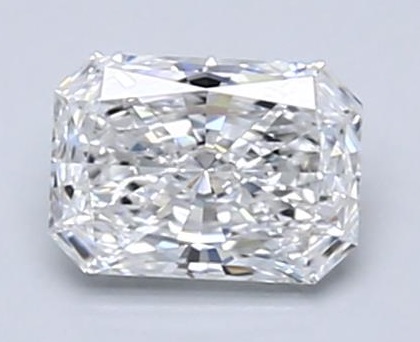
Radiating concentric rings seen in a radiant cut diamond.
The radiant cut can be thought of as a hybrid which combines advantages of the three most popular diamond shapes. It has the fire and brilliance of the round cut brilliant, the clipped corners of the wonderful Asscher cut and the “openness” of the emerald cut.
With a unique embodiment of different traits, it appeals to people who are looking for a modern-fusion look in their engagement rings. If you are shopping for a radiant cut diamond engagement ring, you have come to the right place.
In this article, I’m going to show you how to pick a beautiful radiant cut diamond and reveal the insider tips that will help you save money. You will find out exactly what to look out for and to avoid when shopping for one.
Let’s jump right in…
Here is a list of topics we will be covering:
- Recommended Proportions For Radiant Cut Diamonds
- Avoid the Dreaded Bow Tie Effect in a Radiant Diamond
- Recommended Color Ratings for Radiant Cut Diamonds
- What is the Best Clarity Rating to Buy for a Radiant Diamond?
- 2 Types of Radiant Cut Diamonds: Rectangular & Squarish
- Ideal Length to Width Ratio for Radiant Cut Diamonds
- How Much Does a Radiant Cut Diamond Cost?
- Best Setting Designs For Radiant Cut Diamond Engagement Rings
- Summary And Recap: Where to Buy Radiant Cut Diamonds
Recommended Proportions For Radiant Cut Diamonds
Unlike the round brilliant diamond, the GIA report does not list a cut grade for a radiant cut diamond. This is because radiant diamonds have many non-standardized facet structures and there can be a wide range of proportions they can be cut to.
Due to the lack of cut information provided by a lab report, it is much harder for an inexperienced shopper to pick out a radiant cut with strong light return. Also, it doesn’t help that the majority of diamonds in the market are poorly cut.
With that said, I’ve compiled a table of ideal proportions that is designed to help you quickly weed out poorly cut diamonds. You may want to use the proportions as a general guideline to start your search when shopping for a diamond.
| Excellent | Very Good | Good | Fair/Poor | |
|---|---|---|---|---|
| Table % | 60% – 66% | 58% – 69% | 57% – 72% | Outside Ranges |
| Depth % | 59% – 65% | 57% – 67% | 56% – 70% | Outside Ranges |
| Polish/Symmetry | Excellent – Very Good | Good | Outside Ranges | |
| Length to Width | 1.00 – 1.20 | 1.21 – 1.25 | 1.26 – 1.35 | Outside Ranges |
| Girdle Thickness | Thin – Thick | V. Thin – V. Thick | Outside Ranges | |
| Culet Size | None | Very Small | Small | Outside Ranges |
Note: The table of ideal proportions should only be used as a reference for filtering and narrowing down your selections.
With fancy cut diamonds, numbers cannot be used to determine or guarantee light performance by themselves. When buying radiants, you will need to consider photography/videography data and include ASET analysis as part of your decision making process.
To help you visualize how a well cut radiant diamond looks like, check out these 2 examples below that are handpicked for their superb brilliance and scintillation patterning. Hopefully, this gives you a better idea of the traits to look out for.
Avoid the Dreaded Bow Tie Effect in a Radiant Diamond
When radiant cut diamonds are polished to poor proportions, it can give rise to issues like dark looking bow-ties. As the name suggests, the bowtie resembles the shape of a man’s bow-tie and it creates ugly looking patches across the diamond’s body.
These dark looking areas are caused by misaligned facets that create light obstruction when a viewer sees the diamond. Below are 2 examples of radiant diamonds with bowtie issues that you want to avoid.
Radiant cut diamonds with ugly bowties that you should avoid.
Here, I want to point out that the GIA grading report makes no mention of the presence of bowties and you need to see the diamond to assess it yourself. This is another reason why I always emphasize the need to utilize videos in unbiased lighting environment when selecting a radiant diamond.
Recommended Color Ratings for Radiant Cut Diamonds

GIA color comparison chart of D to K ratings.
Radiant cut diamonds generally have lesser brilliance and sparkle compared to round diamonds due to their cutting style. As a result, radiant cut diamonds tend to reveal their body color more readily.
If you are looking for an icy white color appearance, I recommend a G or better color grade. For larger carat size diamonds above 2ct, you would probably need an F color grade to ensure a white appearance.
On the other hand, if you prefer a yellow gold setting or vintage looking appearance, going down to lower color ratings would be perfectly fine. The warm tint exhibited by the diamond can actually help complement the style of the ring you are looking for.
While I personally prefer a white looking diamond, evaluating color in radiant cut diamonds is subjective. At the end of the day, you should choose a color grade that your recipient prefers.
What is the Best Clarity Rating to Buy for a Radiant Diamond?
When it comes to clarity, the radiant cut diamond is not good at concealing inclusions because of their large table facet and generally poor light return. Speaking broadly, you would typically require a VS2 or better clarity grade to get an eyeclean diamond.
The caveat is that you must always use a magnified video taken under unbiased lighting conditions to help you evaluate eyecleanliness. As the examples below show, the inclusions found in VS2 diamonds can be vastly different and it is no guarantee of an eyeclean diamond.
Can you tell which is the eyeclean diamond between these 2 examples?
Also, depending on the carat size of the diamond you are getting, you may require a higher clarity rating (for large sized diamonds) or may even go lower to SI1 clarity at smaller carat sizes to save costs.
Pro tip: Due to the limited selections available for radiant cut diamonds, you should also keep an open mind about buying higher clarity grades and focus on getting a well cut diamond instead.
2 Types of Radiant Cut Diamonds: Rectangular & Squarish
Radiant cut diamonds are traditionally cut to rectangular outlines but there are also some cutting styles which result in square looking outlines. Very often, people confuse square cut radiant diamonds with the cushion cut because of their squarish outlines.
However, you can tell them apart by looking at their corners. Radiant cut diamonds have straight cut corners while cushion cut diamonds have curved corners which gives them more of a contemporary feel.
This is also the reason why radiant cut diamonds are technically classified as “cut corner rectangular modified brilliant” or “cut corner square modified brilliant” by the GIA. Basically, you can think of radiant cut diamonds as princess cut diamonds with their 4 corners cut off.
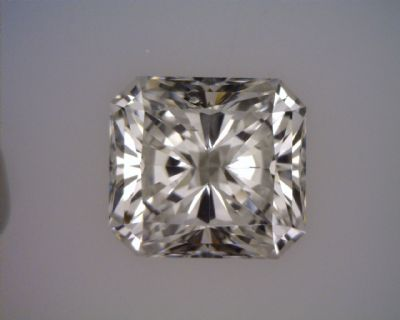
Square radiant cut
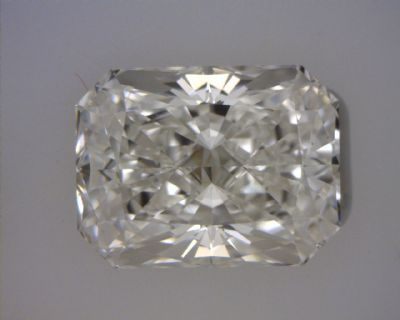
Rectangle radiant cut
So what’s the difference between a square and a rectangle radiant cut diamond? In terms of optical properties, a radiant diamond that is more squarish typically has better brilliance and sparkle factor.
On the other hand, an elongated stone is known to have more of a fiery presence and a better spread of light scintillation.
Ideal Length to Width Ratio for Radiant Cut Diamonds
The length to width ratio of a radiant cut diamond will determine its outline and shape appeal. My personal preference lies with the range of 1.15-1.25 where the diamond takes on a slightly rectangular outline.
This is the range where the facet structure works best to bring out the concentric appearance and traditional flavor of a radiant cut stone. For a quick and easy reference, here’s a chart that depicts how radiant cuts with different length to width ratios would look like.

Do note that there are diverse preferences when it comes to shape appeal in radiant cut diamonds. If you aren’t sure, you may want to review diamonds with different length to width ratios to find out your preferences.
Some people may prefer a perfectly square 1:1 ratio and that’s perfectly fine. Some people like elongated shapes which derails from a traditional appearance.
Personally speaking, if I wanted to buy a square shaped or elongated diamond, I would rather purchase a princess cut or marquise instead of a radiant diamond.
How Much Does a Radiant Cut Diamond Cost?
Compared to round diamonds, the prices of radiant cut diamonds are generally 25-30% lower per carat weight. This means that you can get a larger sized diamond for less money if you are on a budget.
Depending on the specifications of the 4Cs, prices can be drastically different. Below, I’ve compiled a price comparison table of 1 carat sized radiant cut diamonds as a reference.

Price comparison of GIA certified 1ct radiant cut diamonds.
As you can see, the cost of a 1ct radiant cut diamond can range anywhere between $2,000 to $8,000. A diamond with the best of the best material specifications of D/FL (~$7,500) costs nearly 3 times as much as another diamond with lower clarity/color ratings.
But here’s the thing, a more expensive diamond doesn’t necessarily mean it will look better or have better sparkle. Diamonds with higher color and clarity ratings are more expensive because of rarity factors.
In fact, you don’t need a D/IF grade for a great looking diamond when a well-cut G/VS2 can look completely identical in the face up view. If you are a practical person or don’t need a D/IF symbolic grade, you can save yourself a tidy sum of money by choosing a lower color/clarity diamond.
Best Setting Designs For Radiant Cut Diamond Engagement Rings
Radiant cut diamonds can make for a great solitaire ring that shows of their distinct traits and concentric patterning. They are also very versatile and can go well with side stone ring designs.
Below, I’ve listed some of my favorite designs that complement the unique style of the radiant cut diamond. In fact, some of these rings are previously purchased engagement rings from other readers.
Hopefully, it can offer ideas and inspire you towards finding your perfect ring setting design.
A classic and affordable 4 prong solitaire ring design with a square cut radiant diamond.
This knife edge ring has rows of pave diamonds that exhibit a vintage vibe from the engagement ring.
The diamond encrusted ring setting enhances the visual size of the center stone and offers immense light play.
This French cut pavé diamond engagement ring offers an unparalleled sparkle factor for a low price.
This cathedral setting lifts the radiant cut diamond towards the eye and accentuates its outline.
An elegant twist pave setting that is perfect for small sized hands and symbolizes your intertwining love.
Summary And Recap: Where to Buy Radiant Cut Diamonds
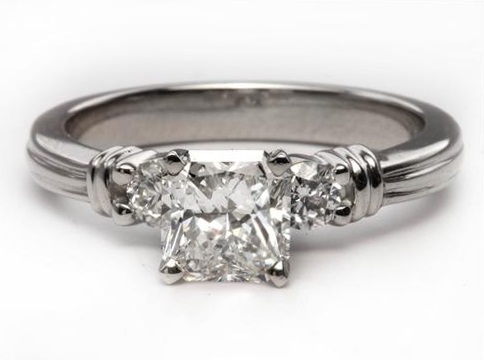
A beautiful radiant cut diamond set between 2 round brilliants.
In general, here’s what I would recommend to people who are interested in buying a radiant cut diamond. For people who are sensitive to color, a minimum color grade of “G” is recommended. In terms of clarity, I would stick with a minimum rating of “VS2”.
I don’t recommend buying blind but if you have no other methods to shop for a diamond, I would shortlist radiants with a depth percentage between 60% and 69% and a table percentage between 59% and 67%.
That will provide a good base to start filtering choices and eliminating possible options. Also, under no circumstances should you buy a diamond without a reliable lab report/certificate that recognizes its material properties and values.
The best places to buy a radiant cut diamond engagement ring would be Blue Nile and James Allen. Both are highly reliable vendors and offer fantastic sales policies where you shop with zero risks.
More importantly, both vendors offer indepth video listings that allow you to review a diamond’s outline, inclusions and cut quality. They also offer an extensive selection of GIA certified diamonds where you get to cherry pick your diamond.
If you need help with a second opinion or to pick out a well cut diamond, drop me an email or leave a comment below and I will reply to your questions. Good luck in your search!
Related Articles
Leave A Comment


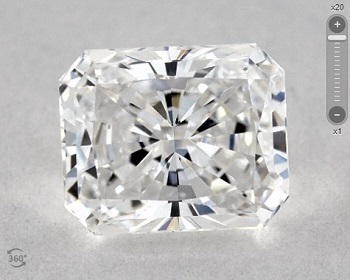

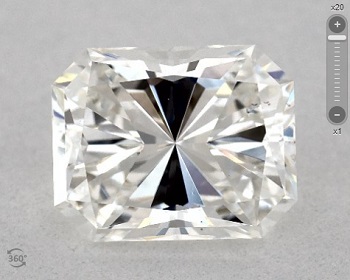
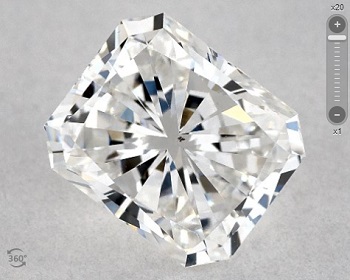
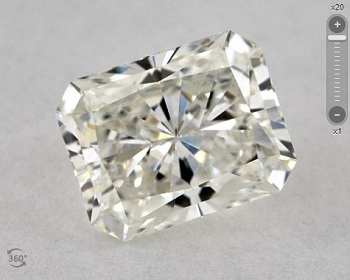





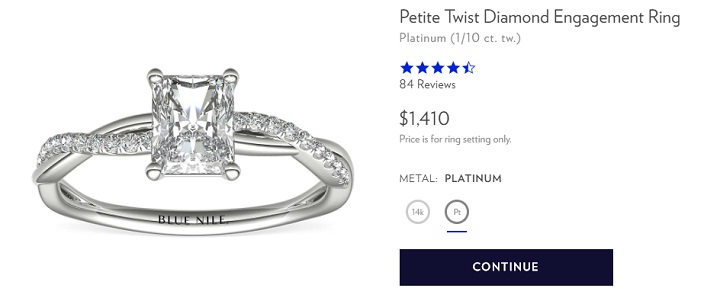
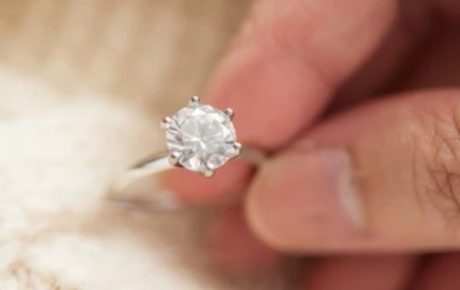

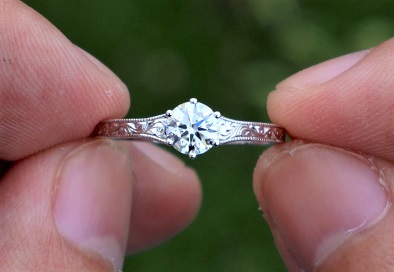










10 Comments
Hi Paul,
Looking at a radiant square cut, not too many to choose from, can you let me know if this is a good one?
https://www.jamesallen.com/loose-diamonds/radiant-cut/1.02-carat-e-color-vvs2-clarity-sku-2525408
The depth is a bit out of your suggestion, so just thought I’d ask.
Thanks!
David
Hey David,
The proportions like table/depth are just a rough guideline. I actually stated so beneath the table.
The diamond you picked is a pretty diamond and has traits of a decently cut radiant diamond. Shape appeal wise, I think it is great.
Paul
What are the differences between a princess cut diamond and a radiant cut diamond? Would you prefer one over the other?
Interestingly from a bureaucratic point of view, the radiant cut does not exist. I know it might sound strange at first, but that is the truth when we go down to the technicalities.
The major gemological institutes like the GIA (Gemological Institute of America) do not issue grading certificates calling these diamonds “radiant cuts”. Instead, they term it as a “cut corner rectangular modified brilliant” or “cut corner square modified brilliant” depending on the diamond’s outline. According to this terminology, a radiant cut diamond could be defined as a princess cut diamond with its corners cut off.
The real differences between a princess cut and a radiant cut lie on the internal facet structures and the 4 truncated corners. In terms of optical performance, the princess cut has a much more linear character in the way it reflects light. On the other hand, the radiant cut diamond present a series of concentric circles radiating from the center.
A comparison of the radiant cut (left) vs. the princess cut (right).
Personally, I do prefer the square princess cut over the radiant. But that’s just me and what matters most is what you like.
I was told that radiant cut diamonds are very forgiving when it comes to hiding inclusions and that it is able make much more of a lesser quality rough stone. Hence, the low price points. This cutting style hides flaws and color tints by making use of the excellent brilliance and scintillation properties it displays. You don’t seem to agree with that. Why?
Any diamond that has strong light return and superb sparkle will do a good job in hiding inclusions. The problem with radiant cuts is that most are extremely leaky. They do NOT have strong light performance. Now, I’m not dinking every single stone but the fact is, roughly 1 out of 100 radiant cut diamonds is somewhat cut properly. It’s hard to find but if you can find that one stone, then it can be “forgiving” when it comes to covering up flaws.
Hi Paul,
I’ve been reading all of your articles and just decided to read these posts/questions. I’m surprised and disheartened from the last comment that you believe radiant cuts have poor light performance. On multiple occasions, I have read that radiant cuts are second to round cuts (or third due to princess). Are you recommending that I stay away from radiant cut diamonds? I am looking for a rectangular shape and feel like I am forced into getting a radiant cut.
My next questions get to the heart of what I have been spending my days researching — I am searching for a rectangular radiant cut lab made diamond from Brilliant Earth.
I have spent weeks on this and it has sucked out the romance and excitement about the whole engagement. Please help me so I can ease my mind that my future fiancé and I will forever keep this diamond and I will look at it with full satisfaction.
Here is what I am looking for:
Lab diamond
2 carats
Yellow gold setting (not sure of the difference between 14 and 18)
Price max $10,000
Rectangular Radiant or in the alternative, Cushion
Ratio of 1.20 or higher
All other specs as you see fit but I’ve been generally looking for at least G and VS2. Feel free to change that.
I have looked at SO MANY websites for my diamond and I’m at a loss at which to pick. The more I read about diamonds, the more difficult it gets. I have found good ones (or what I believe them to be) on websites that provide settings that I am not quite interested in but I might just deal with it if necessary. I will list them anyway…
Brilliant Earth (Preferred website due to available settings. However, if your ranges on your website change due to rectangular Radiant or Cushion cuts, then I would have to start over lol.)
Radiant:
https://www.brilliantearth.com/lab-diamonds-search/view_detail/9277584/
Due to COVID-19 issues, they have indicated that ASET images are impossible.
https://www.brilliantearth.com/lab-diamonds-search/view_detail/9342435/
I know this only has one image but I can’t find much with my criteria on this website.
Cushion:
https://www.brilliantearth.com/lab-diamonds-search/view_detail/9134908/
(IGI certificate on website) I am very reluctantly listing this due to the low ratio.
https://www.brilliantearth.com/lab-diamonds-search/view_detail/9277387/
https://www.brilliantearth.com/lab-diamonds-search/view_detail/8294669/
(GCAL certificate on website) Not too happy with all the “very good” ratings but I’ll leave that up to you.
First, do your suggested ranges for depth and table percentages change when buying a rectangular radiant diamond?
Second, is it just me or does this bow-tie effect seem almost impossible to avoid?
I’m having a very difficult time picking a diamond and would appreciate your advice!! THANK YOU!
Sorry for the delay in reply. I understand how you feel about the process and it can get overwhelming for fancy cut diamonds.
For a yellow gold setting, color won’t be such a big issue. It’s perfectly fine to go with G, H or Is. A D color diamond is going to look yellow anyway in a yellow gold setting.
Setting wise, I’m of no good help here as it depends on your preference and I don’t try to influence readers with their choices in this aspect. I will just say that Brilliant Earth has superb craftsmanship. So, that should put your mind at ease.
I’ve bought a number of rings from them and they all pass my reviews. FYI: https://beyond4cs.com/vintage-engagement-rings/
I’ve looked at all the diamonds you picked. And honestly, I can see that you did your research very well. You clearly know what you are doing and the diamonds do have STRONG light return. I don’t usually say this but most readers actually pick poorly cut stones. That’s not the case here.
Now, out of these diamonds, this is my absolute top pick. It’s the one with the best light performance and it gets you value for money.
2.14 Carat Cushion Lab Created Diamond Ideal Cut • H Color • VS2 Clarity
This would be my 2nd choice:
2.07 Carat Radiant Lab Created Diamond Super Ideal Cut • G Color • VS2 Clarity
I really see no reason to go for the 2nd stone given your circumstances with a yellow gold setting. And the H diamond is the one I would personally buy. So, that should say a lot. Good job in picking these out.
Go for the H diamond or at least put it on hold immediately.
Hope this helps. And stay safe.
Hi Paul,
My husband bought a diamond and setting from the Blue Nile in 2008, but in Feb 2019 the setting broke without me noticing and I lost my diamond. It was a radiant cut diamond, 1.54 carat, E color, VS2, table 69%, Depth 62.9%, and measurements 6.98 x 6.61 x 4.16mm. I loved my old ring but now I need to replace it. I bought another ring and diamond but I was not happy with it. I tried to like it but it just was not like my other diamond. So I contacted Blue Nile before the 30 days, and the sales associate started a claim. The sales associate stated I no longer needed to worry about the 30 days because the return process was started. I live in Canada, and the physical ring was not returned to the USA in the 30 day period because I trusted the sales associate and was a few days late. Now Blue Nile states I can only exchange my ring for an equal or greater price, and I only have until Jan 30, 2021. I am considering another diamond at blue Nile but it is literally $10,000.00 more than my previous diamond. I am trying to find a diamond as close to my original diamond, but the choices are limited. Can you please give me your opinion on this diamond? It is a blue nile diamond and the stock number LD01935243. It is E color and 1.93 carats.
Thank you,
Esther
The traditional radiant cut diamonds tend to have an elongated outline instead of a squarish outline. The diamond that you picked has a more squarish outline. To be clear, there’s nothing wrong with it and I’m just highlighting something that is of personal tastes. Performance wise, I can tell you that this is a solid choice with a diamond that has strong light performance.